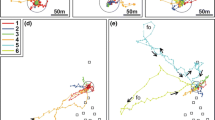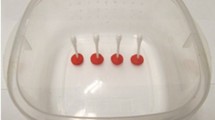Summary
The foraging behavior of a single bee in a patch of four electronic flower dummies (feeders) was studied with the aim of analyzing the informational components in the choice process. In different experimental combinations of reward rates, color marks, odors and distances of the feeders, the behavior of the test bee was monitored by a computer in real time by several devices installed in each feeder. The test bee optimizes by partially matching its choice behavior to the reward rates of the feeders. The matching behavior differs strongly between “stay” flights (the bee chooses the feeder just visited) and “shift” flights (the bee chooses one of the three alternative feeders). The probability of stay and shift flights depends on the reward sequence and on the time interval between successive visits. Since functions describing the rising probability of stay flights with rising amounts of sucrose solution just experienced differ for the four feeders, it is concluded that bees develop feeder-specific memories. The choice profiles of shift flights between the three alternative feeders depend on the mean reward rate of the feeder last visited. Good matching is found after visits to the low-reward feeders and poor matching following departure from the high-reward feeders. These results indicate that bees use two different kinds of memories to guide their choice behavior: a transient short-term working memory that is not feeder-specific, and a feeder-specific long-term reference memory. Model calculations were carried out to test this hypothesis. The model was based on a learning rule (the difference rule) developed by Rescorla and Wagner (1972), which was extended to the two forms of memories to predict this operant behavior. The experiments show that a foraging honeybee learns the properties of a food source (its signals and rewards) so effectively that specific expectations guide the choice behavior.
Similar content being viewed by others
References
Buttel-Reepen H (1900) Sind die Bienen Reflexmaschinen? Exp Beitr Biol Honigbiene 20:1–84
Couvillon PA, Bitterman ME (1985) Analysis of choice in honeybees. Anim Learn Behav 13:246–252
Emlen JM (1966) The role of time and energy in food preference. Am Nat 100:611–617
Forel A (1910) Das Sinnesleben der Insekten. Reinhardt, München
Frisch K von (1914) Der Farbensinn und Formensinn der Biene. Zool Jb Physiol 37:1–238
Frisch K von (1965) Tanzsprache und Orientierung der Bienen. Springer, Heidelberg
Heinrich B (1972) Energetics of temperature regulation and foraging in a bumblebee, Bombus terricola. J Comp Physiol 77:49–64
Heinrich B (1975) Energetics of pollination. Annu Rev Ecol Syst 6:139–170
Heinrich B (1979) “Majoring” and “minoring” by foraging bumblebees, Bombus vagans: an experimental analysis. Ecology 60:245–255
Heinrich B (1979) Resource heterogenity and patterns of movement in foraging bumblebees. Oecologia 40:235–245
Heinrich B (1981) The energetics of pollination. Ann Missouri Bot Gard 68:370–378
Heinrich B (1983) Do bumblebees forage optimally, and does it matter? Am Zool 23:273–281
Heinrich B (1984) Learning in Invertebrates. In: Marler P, Terrace HS (eds) The biology of learning (Dahlem Konferenzen). Springer, Berlin Heidelberg New York Tokyo, pp 135–147
Heinrich B, Mudge PR, Deringis PG (1977) Laboratory analysis of flower constancy in foraging bumblebees: Bombus ternarius and B. terricola. Behav Ecol Sociobiol 2:247–265
Herrnstein RJ (1970) On the law of effect. J Exp Anal Behav 13:243–266
Kamil AC, Roitblat HL (1985) The ecology of foraging behavior: implications for animal learning and memory. Annu Rev Psychol 36:141–169
Lindauer M (1963) Allgemeine Sinnesphysiologie. Orientierung im Raum. Fortschr Zool 16:58–140
MacArthur RE, Pianka ER (1966) On optimal use of patchy environment. Am Nat 100:603–609
Marden JH, Waddington KD (1981) Floral choices by honeybees in relation to the relative distances to flowers. Physiol Entomol 6:431–435
Menzel R (1967) Untersuchungen zum Erlernen von Spectralfarben durch die Honigbiene (Apis mellifera). Z Vergl Physiol 56:22–62
Menzel R (1985) Learning in honey bees in an ecological and behavioral context. In: Hölldobler B, Lindauer M (eds) Experimental behavioral ecology. Gustav Fischer, Stuttgart, pp 55–74
Menzel R (1987) Memory traces in honeybees. In: Menzel R, Mercer A (eds) Neurobiology and behavior of honeybees. Springer, Berlin, pp 310–325
Menzel R (1990) Learning, memory, and “cognition” in honey bees. In: Kesner RP, Olten DS (eds) Neurobiology of comparative cognition. Erlbaum, Hillsdale NJ, pp 237–292
Nunez JA (1970) The relationship between sugar flow and foraging and recruiting behavior of honey bees (Apis mellifera L.). Anim Behav 18:527–538
Pflumm W (1984) Rate of supply of the sugar solution and behavior of the nectar gathering honeybee — a comparison between natural and artificial food sources. Zool Jb Physiol 88:457–470
Pyke GH (1978) Optimal foraging: movement patterns of bumblebees between inflorescences. Theor Popul Biol 13:72–98
Pyke GH (1978) Optimal foraging in bumblebees and coevolution with their plants. Oecologia 36:281–293
Pyke GH (1984) Optimal foraging theory: a critical review. Annu Rev Ecol Syst 15:523–575
Pyke GH, Pulliam HR, Charnov EL (1977) Optimal foraging: a selective review of theory and tests. Q Rev Biol 52:137–154
Real LA (1991) Animal choice behavior and the evolution of cognitive architecture. Science 253:980–986
Rescorla RA, Wagner AR (1972) A theory of classical conditioning: variations in the effectiveness of reinforcement and non-reinforcement. In: Black AH, Prokasy WF (eds) Classical conditioning II: Current research and theory. Appleton-Century-Crofts, New York, pp 64–99
Schmid-Hempel P (1984) The importance handling time for the flight directionality in bees. Behav Ecol Sociobiol 15:303–309
Schmid-Hempel P (1985) How do bees choose flight direction while foraging? Physiol Entomol 10:439–442
Schmid-Hempel P (1987) Efficient nectar-collecting by honeybees. J Anim Ecol 56:209–218
Schmid-Hempel P, Kacelnik A, Houston AI (1985) Honeybees maximize efficiency by not filling their crop. Behav Ecol Sociobiol 17:61–66
Schmid-Hempel P, Wolf TJ (1988) Foraging effort and life span of workers in a social insect. J Anim Ecol 57:509–521
Seeley TD (1985) The information-center strategy of honeybee foraging. Fortschr Zool 31:75–90
Staddon JE (1983) Adaptive behavior and learning. Cambridge University Press, New York
Stephens DW, Krebs JR (1991) Foraging theory. Princeton University Press, Princeton, N.J., pp 1–247
Sutton RS, Barto AG (1981) Towards a modern theory of adaptive networks: expectation and prediction. Psychol Rev 88(2):135–170
Varju D, Nunez J (1991) What do foraging honeybees optimize? J Comp Physiol 169:729–736
Waddington KD (1982) Honey bee foraging profitability and round dance correlates. J Comp Physiol 148:297–301
Waddington KD (1985) Cost-intake information used in foraging. J Insect Physiol 31:891–889
Waddington KD (1990) Foraging profits and thoracic temperature of honey bees (Apis mellifera). J Comp Physiol 160:325–329
Waddington KD, Gottlieb N (1990) Actual vs percieved: a study of floral choice of honey bees. J Insect Behav 3:429–441
Waddington KD, Heinrich B (1981) Patterns of movement and floral choice by foraging bees. In: Kamil A, Sargent T (eds) Foraging behavior. Garland Press, New York, pp 215–230
Waddington KD, Holden LR (1979) Optimal foraging: on flower selection by bees. Am Nat 114:179–196
Wolf TJ, Schmid-Hempel P, Ellington CP, Stevenson RD (1989) Physiological correlates of foraging efforts in honey-bees: oxygen consumption and nectar load. Funct Ecol 3:417–424
Author information
Authors and Affiliations
Additional information
Correspondence to: R. Menzel
Rights and permissions
About this article
Cite this article
Greggers, U., Menzel, R. Memory dynamics and foraging strategies of honeybees. Behav Ecol Sociobiol 32, 17–29 (1993). https://doi.org/10.1007/BF00172219
Received:
Accepted:
Issue Date:
DOI: https://doi.org/10.1007/BF00172219




